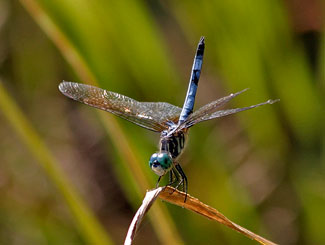Till it's gone. They paved paradise, And put up a parking lot -- From Big Yellow Taxi by Joni Mitchell Knowing what natural resources a community possesses is a critical step towards protecting them. Such information can also help avoid environmental train wrecks that pit local conservationists against developers and leave residents dissatisfied with local government. Two recently identified, globally rare plant communities at Silver Lake are a case in point. One of these is an Upland Depression Swamp, a kind of seasonally flooded forested wetland composed of wet-tolerant plants such as pin oak, greenbrier, and jewelweed. Since they are unconnected to a stream or other water body, they are classified as isolated wetlands. Upland Depression Swamps occur in a highly restricted range almost entirely within the metropolitan Washington, DC portion of the Culpeper Basin. The basin is an ancient rift valley and today consists of flat, low lying land from central Virginia into Maryland and includes a significant portion of Prince William County. The highly limited range of Upland Depression Swamps coincides with large-scale suburban development, placing this plant community at high risk for disappearance. NatureServe, an international network of natural heritage programs, rates Upland Depression Swamps as G2, meaning they are globally imperiled; Virginia ranks them as S2 or state rare. The other, larger threatened plant community at Silver Lake is a Basic Oak-Hickory Forest (Northern Hardpan Type) and rated by NatureServe and the state as G3 and S3, respectively, meaning this community type is vulnerable to extirpation. The term “basic” refers to this community’s occurrence on basic, as opposed to acidic soil. These basic soils derive from the underlying diabase (a.k.a. bluestone) and metabasalt rocks common in the Culpeper Basin. Basic soil is more fertile than acidic soil, so this community supports a high level of plant diversity. Fertile soils are also attractive to farmers and much of this forest type has been converted to agriculture. More has been lost to pine plantations and, more recently, urban development. The threatened plant communities at Silver Lake have already been slated for development and will be lost if a land swap can’t be arranged. Unlike endangered species, rare ecosystems don’t get much legal protection. If these natural resources had been identified earlier, development of the Silver Lake area could have been planned to avoid them. This is why a natural resources inventory of Prince William County is so important and, given the rapid pace of development, very overdue. The Prince William Park Authority 2005-2010 Strategic Plan calls for such an inventory of park sites and for a countywide plan for “…protecting, enhancing, and promoting natural resources…” There is no reason to delay these measures and, as the Silver Lake case illustrates, every reason to move forward now before more local paradises are lost. For more on these plant communities, see: Nature Serve Dept. of Conservation & Recreation, Natural Heritage, Natural Communities of Virginia Cliff Fairweather is a naturalist with wide experience in conservation issues throughout Northern Virginia. |
Home | Upcoming Events | About Us | Resource Issues | News | Local Contacts
Maps | Photos | Publications | Youth Education | FAQ's | Links | Membership







 Protecting Natural Resources:
Know What You've Got Before It's Gone
Protecting Natural Resources:
Know What You've Got Before It's Gone